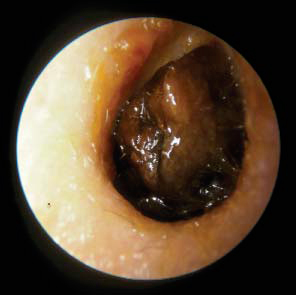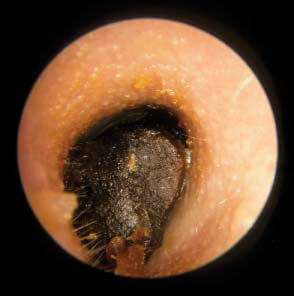Etiology
Etiology is multifactorial. Some people form more cerumen than others, presumably as a result of genetic factors. There is some evidence that different genetic phenotypes result in dry or wet cerumen, for example dry earwax is frequent in East Asians, whereas wet earwax is common in other populations.[3][4] People who have narrow ear canals are more susceptible to cerumen impactions because it takes less cerumen to occlude their canals.
The aging process decreases the number and activity of ceruminous glands, resulting in a drier type of cerumen.[2][4] The increase in ear-canal hair in older men contributes to cerumen impaction in this population.
Other risk factors for cerumen impaction include instrumentation of the ear canals with cotton-tip applicators and the repeated insertion of a hearing aid.[4]
Pathophysiology
Cerumen consists of layers of desquamated keratin from epithelial cells that mixes with secretions from sebaceous and ceruminous glands that are located in the lateral part of the ear canal. The function of cerumen is to clean and lubricate the ear canal.[2] As the cerumen migrates laterally toward the meatus, dirt, dust, and hair are carried with it. Cerumen may also protect the ear canal from bacteria, fungi, and insects.[2]
Cerumen accumulates when the migration process becomes compromised, due to wax consistency, ear canal anatomy, age, increased hair, or instrumentation of the ear canal. The occlusive effect of the cerumen impaction often results in symptoms of fullness and decreased hearing. Occasionally, the cerumen impaction will also cause tinnitus, coughing, and vertigo, although vertigo is rare and may occur when the ear wax pushes against the tympanic membrane. The presence of water in the canal, either by bathing or by attempted irrigation of the cerumen, may lead to swelling of the cerumen with subsequent exacerbation of symptoms of fullness and hearing loss. The impacted cerumen may trap bacteria in the medial ear canal that can cause an infection of the canal in the form of external otitis with symptoms of pain and drainage, with objective findings of foul-smelling debris, and redness and/or swelling of the ear canal skin.
Genetic studies show "wet" and "dry" cerumen phenotypes that appear to be located on chromosome 16.[5][6] The wet cerumen is light or dark brown and sticky with a relatively high concentration of lipid and pigment granules. The dry type is gray or tan and brittle and has a lesser concentration of lipid and pigment granules.[Figure caption and citation for the preceding image starts]: Wet cerumenReprinted with permission from: Hawke M. Ear disease: a clinical guide. Hamilton, London: Decker DTC, 2003 [Citation ends]. [Figure caption and citation for the preceding image starts]: Dry cerumenReprinted with permission from: Hawke M. Ear disease: a clinical guide. Hamilton, London: Decker DTC, 2003 [Citation ends].
[Figure caption and citation for the preceding image starts]: Dry cerumenReprinted with permission from: Hawke M. Ear disease: a clinical guide. Hamilton, London: Decker DTC, 2003 [Citation ends].
Use of this content is subject to our disclaimer